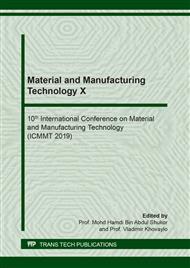p.3
p.8
p.13
p.18
p.23
p.29
p.35
p.40
p.48
Enhancement of Impact Toughness in Mild Steel Weldments under Low Temperature Applications
Abstract:
In this research, mild steel weldments are tested by varying nickel content into the weld beads. Three mild steel plates have been joined using three electrodes with similar chemical composition except nickel content 0%, 9-11% and 19-21% respectively, by SMAW process and keeping heat input constant at all. The performance of welded specimens was evaluated by Charpy V-notch impact tests under different temperature conditions (25°C, 0°C, -20°C, -40°C, -60°C). It was found that the weldment with 0% nickel content is suffering rapid transition from ductile to brittle at-60°C, thus toughness reduces to approximately 1/5th of its value at room temperature. Microstructure revealed that at inter-dendritic regions mainly martensite was found. In dendrite core regions of the low carbon weld metals, a mixture of upper bainite, lower bainite and a novel constituent coalesced bainite formed. The fractured surface pattern was also observed using SEM, to reveal the ratio of area underwent ductile or brittle type of failure.
Info:
Periodical:
Pages:
23-28
Citation:
Online since:
March 2020
Authors:
Price:
Сopyright:
© 2020 Trans Tech Publications Ltd. All Rights Reserved
Share:
Citation:


